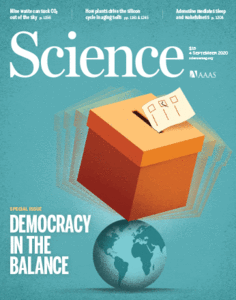 Science has a special feature in its 4 September 2020 issue on “Democracy in the Balance” arguing for urgent scientific study of what will help democracy survive and hopefully flourish. Introducing the special feature, Tage Rai and Brad Wible observe that democracy is losing ground. “Advances in technology are making it easier to distort true voter representation . . . political campaigns continue to struggle with reaching voters and persuading them to participate. Worryingly, state violence, which has always been a core feature of the democratic experience for some, is spreading in democratic societies.” A scientific understanding of the phenomena that underlie democracy’s operation, Rai and Wible argue, may help us enhance it. [1]
Science has a special feature in its 4 September 2020 issue on “Democracy in the Balance” arguing for urgent scientific study of what will help democracy survive and hopefully flourish. Introducing the special feature, Tage Rai and Brad Wible observe that democracy is losing ground. “Advances in technology are making it easier to distort true voter representation . . . political campaigns continue to struggle with reaching voters and persuading them to participate. Worryingly, state violence, which has always been a core feature of the democratic experience for some, is spreading in democratic societies.” A scientific understanding of the phenomena that underlie democracy’s operation, Rai and Wible argue, may help us enhance it. [1]
Deen Freelon, Alice Marwick and Daniel Kreiss argue that in the industrialized West, left- and right-wing activists use digital and legacy media differently to achieve their political goals. Left-wing actors operate more strongly through offline protest. Right-wing activists manipulate legacy media, migrate to alternative platforms, and work strategically with partisan media. Isolation of the far right from the rest of the ideological spectrum results in asymmetric polarization and disinformation is a function of right-wing media. We do not know enough about how processes on the left of politics work; they are not equivalent or similar to those on the right. [2]
Susan Hyde argues for a better understanding of how even a superficial experience of democratic institutions may influences citizen behaviour when formal democratic institutions erode or disappear. Are citizen movements alone sufficient to restrain autocracy? [3]
Rohini Pande asks, “Can democracy work for the poor? Science 369, no. 6508 (4 Sep 2020): 1188–92. Millions of the world’s poorest live in middle-income democracies thatcould use their resources to end extreme poverty. But this rarely happens. Somehow we must also improve democratic institutions so that vulnerable populations themselves can push for redistributive policies. But how? [4]
Delia Baldassarri and Maria Abascal identify two features of modern societies—social differentiation and economic interdependence—that can set the stage for constructive interactions with dissimilar others. Whether societal adaptations to diversity lead toward integration or division depends on the positions occupied by minorities and immigrants in the social structure and economic system, along with the institutional arrangements that determine their political inclusion. [5]
1. Tage Rai and Brad Wible, “In flux and under threat,” Science 369, no. 6508 (4 Sep 2020): 1174–5.
2. Deen Freelon, Alice Marwick and Daniel Kreiss “False equivalencies: Online activism from left to right,” Science 369, no. 6508 (4 Sep 2020): 1197-120
3. Susan D. Hyde, “Democracy’s backsliding in the international environment,” Science 369, no. 6508 (4 Sep 2020):1192–6.
4. Rohini Pande, “Can democracy work for the poor? Science 369, no. 6508 (4 Sep 2020): 1188-92.
5. Delia Baldassarri and Maria Abascal, “Diversity and prosocial behavior,” Science 369, no. 6508 (4 Sep 2020): 1183-7.